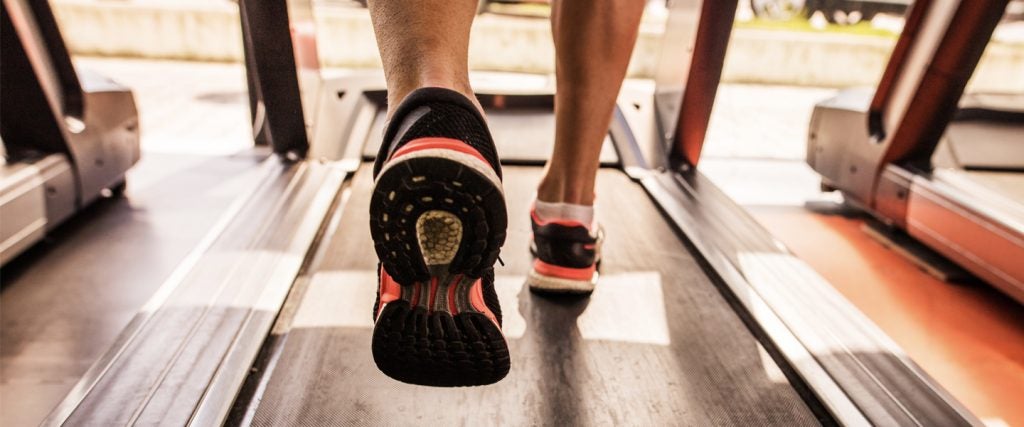Purchasing a pair of running shoes has become an increasingly more complicated endeavor than anyone ever envisioned. In the contemporary age, if you’re dead serious about your running, you’re going to run your hind end straight over to a shop like Runners Need and have a gait analysis performed so that their staff can dissect your form and offer you a pair of running shoes that can accommodate where your feet strike the ground. Essentially, if you’re a toe-striker, midpoint-striker or heel-striker, there’s a set of shoes tailored to accommodate your particular style of running, with additional consideration given to the tilt of your foot.
The way my feet hit the ground is part of my style of running?
I may have misspoke: To many elite runners, your “style of running” can be classified as either good or not good, meaning that your particular running style may just be an accumulation of bad habits and form flaws. If you ask the pros, no one should be striking the ground with their heels, and purchasing a shoe to accommodate this form flaw is akin to waving the white flag and deciding that your technical inability to run well is its own unique style.
I can only dream about how much better life would have been if my calculus teacher had deduced that my mathematical failings were the result of a style flaw that we could agree to disagree on. Math doesn’t work that way, and apparently running feet don’t either. The word I’ve received from my superstar running friends is that a proper gait analysis should culminate in an explanation of how to rectify your style flaws, and not with a sales pitch that preys on your unaddressed locomotive deficiencies. If your feet aren’t striking the ground in a manner that would have you defined as a toe- or midpoint-striker, then you should work on fixing your style, not on buying shoes to camouflage the problem.
Were shoes always built with different running styles in mind?
You’re kidding, right?
In the latter half of the 19th century, the only distinction of substance appears to have been made between running shoes and walking clogs. In an interview recorded in a December 1881 edition of the New York Sun, shoemaker Thomas Maguire offered his opinion of what constituted a running shoe of suitable construction.
“Here lately I have made a great many shoes for members of athletic clubs,” Maguire told the newspaper. “In making a shoe for running, the object is to make it fit like a glove so that the foot shall not slip in the shoe at all. It must be built so as to brace the foot in the direction of the strain. In making such shoes, the measure is taken upon the naked foot, and the shoe is at least three sizes smaller than an ordinary shoe. A properly made running shoe fits as easy as the skin and as close.”
Even as the false premise predominated that the cushionless, unforgiving shoes being fashioned for athletic club members were ideal for galloping across distances of all sorts, the foundation for the shoe model that would eventually replace the pre-20th-century running shoe as the standard for distance running was already in existence, as evidenced by this December 1877 excerpt from The Manchester Weekly Times and Examiner: “Lawn tennis shoes, with their indiarubber soles, are indispensable; the high-heeled boots of the period cut up the grass if tennis is played actually on a lawn, and are dangerous besides for the quick movements demanded in the game.”
By the 1900s, rubber-soled, tennis-style shoes appeared to have replaced the original model of running shoes as the standard athletic footwear of most individuals.
That’s cool and all, but if I do all of my running on a treadmill, what type of shoes should I buy?
Quite honestly, you can get by perfectly well with whatever shoes you’ve purchased for your outdoor runs, which is to say that there’s nothing special about running on the treadmill that necessitates a special purchase with those indoor training efforts in mind. If your heel strikes the ground first when you run on your city’s sidewalk outside, it’s going to strike the ground first when you run on a treadmill inside. At any rate, when you have your gait analyzed, chances are that the analysis is going to be conducted while you’re running on a treadmill, so that’s going to be your likely starting point no matter what.
You can’t make any recommendations at all?
The only advice I’ll dispense is that you take the time to correct your running form now, and then make any high-dollar shoe investments after those adjustments have been made. Because like my coaches always told me, “Practice doesn’t make perfect; practice makes permanent.”

